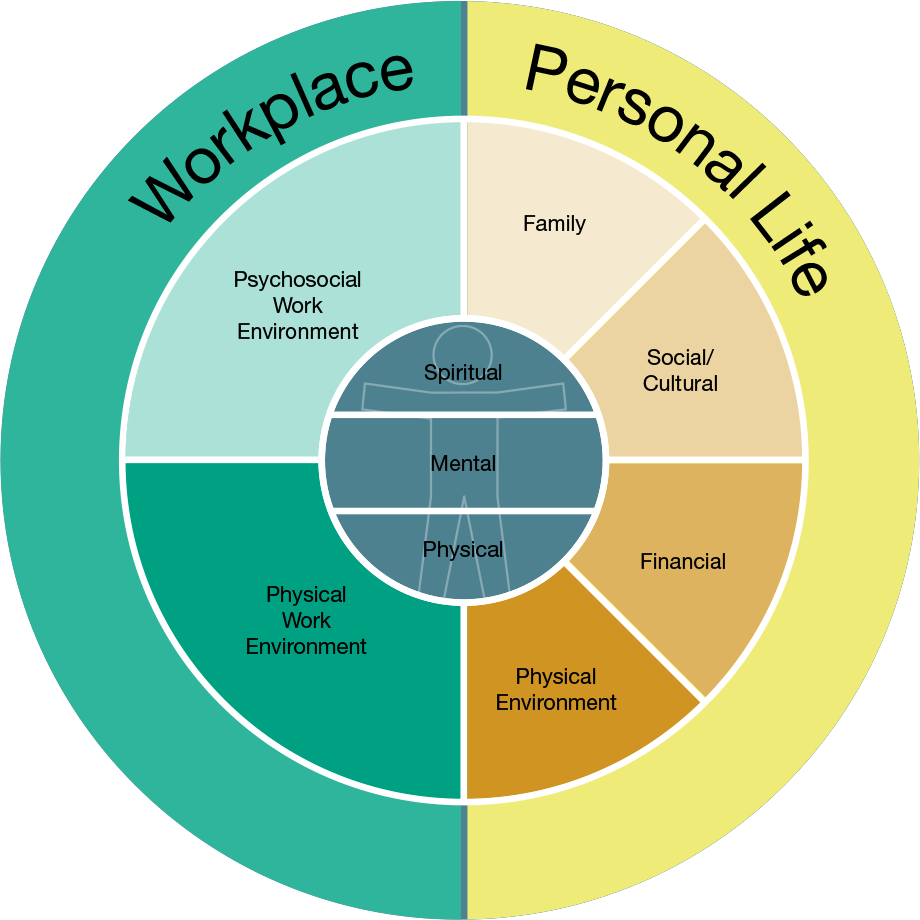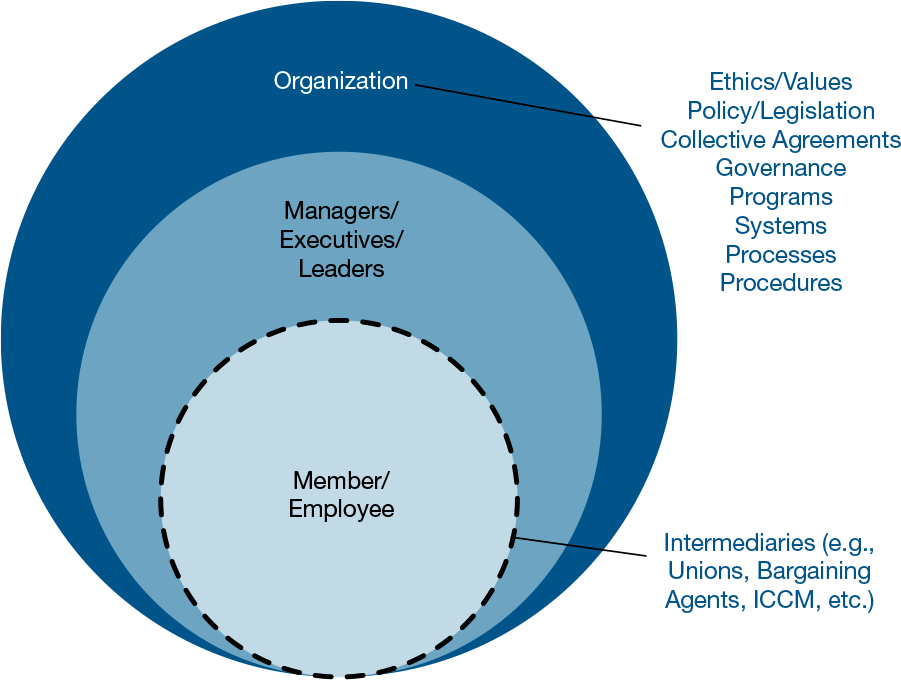2.0 Strategic Framework: Total Health and Wellness
The Total Health and Wellness Strategic Framework moves beyond the focus on physical and mental health. It considers the full spectrum of health and wellness from our personal life to our workplace. It includes prevention activities such as health promotion and education, assessment, as well as care and support. The framework also identifies the spheres of influence that drive positive behaviour change throughout the organization.
This framework will guide the development of new initiatives. It will also help steer the management of existing programs and tools designed to help leaders support diverse members of the Defence Team in achieving health and wellness at home and in the workplace.
Ottawa Charter for Health Promotion’s definition of “Health”:
“the extent to which an individual or group is able, on the one hand, to realise aspirations and satisfy needs [fitness]; and, on the other hand, to change or cope with the environment [resilience]. Health is, therefore, seen as a resource for everyday life, not the objective of living; it is a positive concept emphasizing social and personal resources, as well as physical capacities.”
(McCartney, et al 2019).
2.1 Dimensions of Health
The Defence Team Total Health and Wellness Strategy is based on a dynamic view of health as outlined in the World Health Organization’s Ottawa Charter for Health Promotion, 1986. This view proposes that health is not simply the achievement of certain physical, psychological and social states—it is the ability to live in a certain way, to manage ourselves and adapt to stressors (physical, mental or otherwise) in our environment. The Ottawa Charter’s emphasis on the relationship between social and environmental factors (i.e., workplace factors) and our health is the reason it was chosen to underpin the conceptual framework for the Defence Team Total Health and Wellness Strategy

Figure 1: Dimensions of Health
Long description
Figure 1 displays a large circle split in half with “Workplace” on one half and “Personal Life” on the other. Within the “Workplace” half, there are further subdivisions which include: “Psychosocial Work Environment” and “Physical Work Environment”. The other half of the circle for “Personal Life” is also further, equally, subdivided with “Family”, “Financial”, Social/Cultural”, and “Physical Environment”. At the center of the circle graphic is one final concentric circle representing “Individual Health” which, itself, is subdivided with “Spiritual”, “Mental”, and “Physical”
The Strategic Framework for Total Health and Wellness identifies nine dimensions of health in three groups: workplace, individual, and personal life. The nine dimensions and their relationships are captured in Figure 1. It represents the individual (physical, mental and spiritual) in the centre, balanced between both the work environment (psychosocial and physical) and their personal life (family, social/cultural, financial and physical environment). It shows that maintaining a positive state of physical, mental and spiritual well-being requires balancing the competing demands of work and life (Workplace/Personal Life). A comprehensive (or “total”) approach to health demands that we look at factors across the workplace, including individual and personal dimensions of health
2.2 Spheres of Influence – A Shared Responsibility
Supporting behavioural change toward the adoption of healthier lifestyles and creating a culture of health and wellness in the workplace is a shared responsibility among individuals, leadership, and the DND/CAF. To be successful, health and wellness initiatives must target all levels of the organization, with people at its core. Canada’s Defence Policy—Strong, Secure, Engaged (SSE)—echoes this sentiment with people at the top of the agenda. Figure 2 defines the main spheres of influence for improving health and wellness outcomes and driving positive behaviour change in the workplace.
Defence Team Members and Mediators
Individual Defence Team members are at the centre of change. Although leadership and organizational conditions have considerable influence over individual wellbeing, it is also important to recognize the control employees/members have over their personal health: through the choices they make and the lifestyles they adopt. Individuals also contribute in important ways to creating a positive psychosocial work environment through interpersonal and social interactions, and by adhering to our determined efforts to remove systemic behaviors that create toxic environments. They are supported by a variety of mediating organizations, such as unions and bargaining agents in the case of Defence civilians. The dotted line in Figure 2 captures the notion that mediating organizations are an enabler of individual health and wellness.
Leaders

Figure 2: Spheres of Influence
Long description
Figure 2 displays three concentric circles with the largest circle representing the “Organization”, the next representing “Managers/Executives/Leaders”, and the smallest within them as “Member/Employee”. Examples provided for “Organization” include: ethics/values, policy/legislation, collective agreements, governance, programs, systems, processes, and procedures. Examples provided for “Member/Employee” include: Intermediaries (e.g., Unions, Bargaining Agents, ICCM, etc.). This graphic conveys that there is a shared responsibility in the adoption of healthier lifestyles among individuals, leadership, and the DND/CAF with people at its core.
Military and civilian leaders throughout the DND/CAF have considerable capacity to influence the well-being of Defence Team members, given their impact on the quality of the workplace through their leadership/management style, role-modeling, coaching, and their capacity to inspire employees/members in the workplace. The example they provide, the expectations they set, the work conditions they create, and their knowledge and interpretation of personnel policy underpin a work climate and culture that, in positive instances, motivates and engages Defence Team members. Leaders are also on the frontline of organizational support as they are in the best position to identify employee/member health and wellness needs and encourage them to take advantage of available resources. Leaders are also critical to enforcing corrective action when negative workplace behaviours compromise the well-being of others.
Health Leadership
Every individual in the organization, regardless of rank or role, can lead by example through their choices and behaviours. Research shows that coworkers play an important role in influencing perceptions, attitudes and behaviours of work colleagues. The Defence Team Total Health and Wellness Strategy encourages DND employees and CAF members to be Health Leaders by embodying and promoting healthy behaviours.
The Organization (DND/CAF)
The Organization is responsible for abiding by legislation, Treasury Board regulations, and it sets the policies, programs, systems (e.g. compensation, grievance, information systems), and processes that direct and support both leaders and their staff in the performance of their jobs. The availability of the right organizational supports—programs and systems with supporting policies/legislation—provides the Defence Team leadership and its members with the necessary tools to address health and wellness issues in the workplace. For example, programs such as the Employee Assistance Program (EAP), for DND civilians and the equivalent Canadian Forces Member Assistance Program (CFMAP) both provide direct assistance, advice and referrals to leaders/employees/members. Organizational policies support positive behaviour changes and prohibit harmful activities. Administrative pay systems support timely compensation and financial well-being. These systems are critical organizational elements to health and wellness.
2.3 Organizational Support – Enabling Total Health and Wellness
The improvement of health and wellness outcomes also requires the development of programming that directly targets the full spectrum of organizational supports. They include (i) assessment, (ii) promotion, empowerment and prevention, and (iii) care and support.
Assessment
Assessment activities are focused on the evaluation and measurement of health, wellness and well-being across individual, work and personal dimensions. The aim of assessment activities is to identify needs and opportunities for health and wellness improvement to support the development of programs and strategies that, in turn, support positive health and wellness outcomes.
Promotion, Empowerment and Prevention
Addressing the root causes of poor health can improve health and wellness outcomes and prevent illness and injury before they happen. This includes prevention activities through empowering programs aimed directly at addressing the root causes (workplace, individual, and personal dimensions) of health and wellness issues.
Care and Support
Preventing health and wellness issues before they emerge is ideal, however when illness and injury do occur, we have an obligation to provide quality care and support. Across the Defence Team, a range of care and support services that span the dimensions of health are available to military members, their families, and civilian members of the Defence Team.
Examples of Organizational Supports include:
Assessment
- Surveys (Public Service Employee Survey, Health and Lifestyle Information Survey, Defence Workplace Well-being Survey); and
- Administrative Reporting (Occupational Health and Safety compliance, Departmental Results).
Promotion and prevention
- Communication campaigns;
- Education and training programs (Strengthening the Forces, PSP health promotion activities); and
- Prevention activities (DFit programs, Road to Mental Readiness (R2MR), Respect in the CAF Workshop and The Path online course).
Care and support
- Clinics;
- Transition Centres;
- Chaplain Services;
- Return to Duty Program;
- Casualty Support;
- National peer support programs;
- CF Member Assistance Program (CFMAP);
- Employee Assistance Program (EAP); and
- Office of Disability Management.
Helping Defence Team Members Manage Disabilities
Supporting Initiative:The Office of Disability Management (ODM) is a new organization that aims to help DND employees remain in the workplace or return to work as early as medically feasible. The ODM is an impartial, collaborative and inclusive service that supports employees and supervisors/managers dealing with disability-related matters.
Benefits for the Defence Team: DND employees managing a disability-related matter now have access to Disability Management Advisors (DMAs) who can provide advice and guidance, support and tools to help employees deal with injury, illness or impairment through to recovery, return to work, medical accommodation or medical retirement.
2.4 Wellness
Collectively, the dimensions, spheres of influence and organizational supports define the total health component of Total Health and Wellness. The concept of wellness builds on these ideas by looking at health challenges from a holistic perspective.
Efforts to improve one’s physical health, mental health and spiritual health cannot be separated from all the demands from other parts of life. Time and resources are limited. Making progress in one area of one’s life can lead to sacrifices in other areas, such as taking time away from family to focus on career development. However, some changes can have positive benefits across multiple dimensions. For example, exercising at the gym or doing regular cardiovascular fitness activities (running, biking, hiking, etc.) not only improves overall physical health, but also decreases stress. Decreasing stress improves mental health, which can, in turn, increase familial health and positive psychosocial health in the workplace.
Wellness is about maximizing potentialFootnote 1 and requires a holistic approach to better manage competing demands across all dimensions of health at the same time. By focusing on wellness, the Defence Team Total Health and Wellness Strategy is targeting the more global challenges faced by Defence Team members as individuals and leaders to balance, align, and integrate competing aspects of work and their personal lives.
To achieve optimal wellness, Defence Team members must take stock of their current health status in all nine dimensions of health and set health priorities and targets to work toward personal health goals. Once personal health goals are set, the alignment and integration of health priorities will facilitate an economy of effort towards those goals.